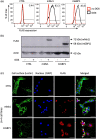Mouse guanylate-binding protein 1 does not mediate antiviral activity against influenza virus in vitro or in vivo
- PMID: 36744765
- PMCID: PMC10952839
- DOI: 10.1111/imcb.12627
Mouse guanylate-binding protein 1 does not mediate antiviral activity against influenza virus in vitro or in vivo
Abstract
Many interferon (IFN)-stimulated genes are upregulated within host cells following infection with influenza and other viruses. While the antiviral activity of some IFN-stimulated genes, such as the IFN-inducible GTPase myxoma resistance (Mx)1 protein 1, has been well defined, less is known regarding the antiviral activities of related IFN-inducible GTPases of the guanylate-binding protein (GBP) family, particularly mouse GBPs, where mouse models can be used to assess their antiviral properties in vivo. Herein, we demonstrate that mouse GBP1 (mGBP1) was upregulated in a mouse airway epithelial cell line (LA-4 cells) following pretreatment with mouse IFNα or infection by influenza A virus (IAV). Whereas doxycycline-inducible expression of mouse Mx1 (mMx1) in LA-4 cells resulted in reduced susceptibility to IAV infection and reduced viral growth, inducible mGBP1 did not. Moreover, primary cells isolated from mGBP1-deficient mice (mGBP1-/- ) showed no difference in susceptibility to IAV and mGBP1-/- macrophages showed no defect in IAV-induced NLRP3 (NLR family pyrin domain containing 3) inflammasome activation. After intranasal IAV infection, mGBP1-/- mice also showed no differences in virus replication or induction of inflammatory responses in the airways during infection. Thus, using complementary approaches such as mGBP1 overexpression, cells from mGBP1-/- mice and intranasal infection of mGBP1-/- we demonstrate that mGBP1 does not play a major role in modulating IAV infection in vitro or in vivo.
Keywords: GTPase; influenza A virus; innate immunity; interferon-stimulated gene.
© 2023 The Authors. Immunology & Cell Biology published by John Wiley & Sons Australia, Ltd on behalf of the Australian and New Zealand Society for Immunology, Inc.
Conflict of interest statement
The authors declare no conflict of interest.
Figures





Similar articles
-
Mouse Mx1 Inhibits Herpes Simplex Virus Type 1 Genomic Replication and Late Gene Expression In Vitro and Prevents Lesion Formation in the Mouse Zosteriform Model.J Virol. 2022 Jun 22;96(12):e0041922. doi: 10.1128/jvi.00419-22. Epub 2022 May 31. J Virol. 2022. PMID: 35638820 Free PMC article.
-
Inducible Guanylate-Binding Protein 7 Facilitates Influenza A Virus Replication by Suppressing Innate Immunity via NF-κB and JAK-STAT Signaling Pathways.J Virol. 2021 Feb 24;95(6):e02038-20. doi: 10.1128/JVI.02038-20. Print 2021 Feb 24. J Virol. 2021. PMID: 33408175 Free PMC article.
-
Induction of Interferon-Stimulated Genes Correlates with Reduced Growth of Influenza A Virus in Lungs after RIG-I Agonist Treatment of Ferrets.J Virol. 2022 Aug 24;96(16):e0055922. doi: 10.1128/jvi.00559-22. Epub 2022 Aug 2. J Virol. 2022. PMID: 35916513 Free PMC article.
-
Interferons, Mx genes, and resistance to influenza virus.Am J Respir Crit Care Med. 1995 Oct;152(4 Pt 2):S67-71. doi: 10.1164/ajrccm/152.4_Pt_2.S67. Am J Respir Crit Care Med. 1995. PMID: 7551417 Review.
-
Modulation of Innate Immune Responses by the Influenza A NS1 and PA-X Proteins.Viruses. 2018 Dec 12;10(12):708. doi: 10.3390/v10120708. Viruses. 2018. PMID: 30545063 Free PMC article. Review.
Cited by
-
Mouse guanylate-binding proteins of the chromosome 3 cluster do not mediate antiviral activity in vitro or in mouse models of infection.Commun Biol. 2024 Aug 25;7(1):1050. doi: 10.1038/s42003-024-06748-8. Commun Biol. 2024. PMID: 39183326 Free PMC article.
References
Publication types
MeSH terms
Substances
Associated data
- Actions
- Actions
LinkOut - more resources
Full Text Sources
Medical
Research Materials

